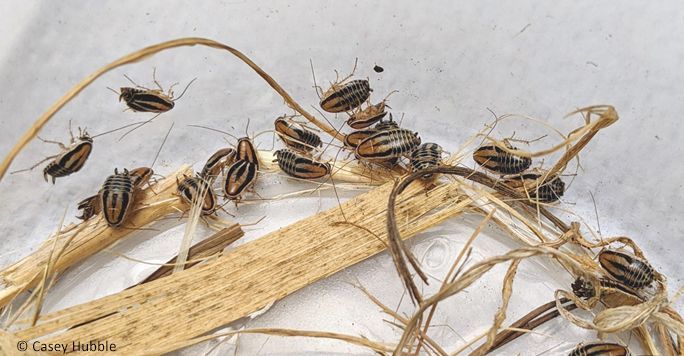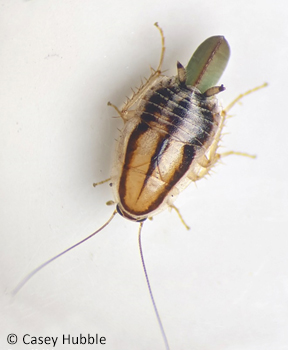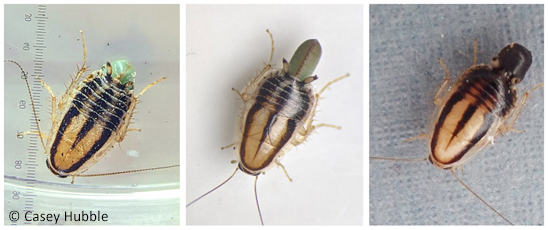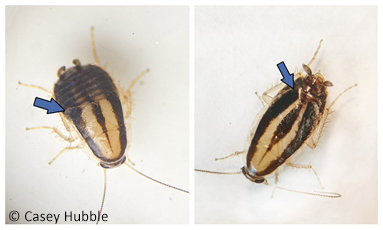
Scampering through leaf litter and grassy landscapes, upon first appearance these flashy little insects might not look like cockroaches, but in fact, they are. They are the smallest cockroaches we have in California, with adults averaging between 5-7mm in length. They are commonly known as the three-lined roach, or if you want to be more scientific, Luridiblatta trivittata; but either way, these charismatic cockroaches are not originally from California, they are native to North Africa and the Eastern Mediterranean.

The three-lined roach first made its debut in California around 2004 in Marin County, but was not positively identified until the Essig Museum’s very own Cheryl Barr, aquatic beetle expert and former Collection Manager, submitted a specimen from her backyard in 2009 to the California Department of Food and Agriculture. Since then, Luridiblatta trivittata has slowly expanded its range to include the Bay Area, San Luis Obispo to the South, to the foothills of El Dorado County in the East, and to Mendocino County to the North.
Though the three-lined roach lives in some of the most densely populated parts of California, these are not the kinds of roaches that want to live in your kitchen. These critters prefer to live outdoors in partially irrigated or dry landscapes and can be found in matted thatch, compost bins, and leaf litter. Occasionally in summer and fall, adults will wander indoors through poorly sealed doors and windows.
We don’t fully understand Luridiblatta trivittata’s biology and ecology, but recent field observations reveal they only have one generation per year. Juveniles hatch around mid-April, and develop through spring and early summer, eventually maturing into adults during July and August. Once mature, females lay egg cases (called oothecae) that will overwinter until next spring. Interestingly, juveniles cannot hatch from their ootheca without precipitation in spring. On the other hand, too much water throughout the overwintering cycle will kill juveniles before they can hatch. It seems our Mediterranean climate, with long dry summers and short wet winters is the Goldilocks of ideal habitats.
Fun three-lined roach facts:
- Knowing your Latin roots in biology can be very helpful in understanding scientific names. Luridiblatta for example, can be broken down into ‘luridus’ meaning something has a wan or yellow coloring, and ‘blatta’, which is Lain for a light-shunning insect (incidentally, all cockroaches are in the group Blattodea). The species name trivittata refers to this particular species. ‘tri’ means to have three, and ‘vitta’ means stripe or line. Therefore, we can conclude that the scientific name is referencing a light-colored cockroach with three lines.

Figure 3: Females with an ootheca at different stages of development - Oothecae of this species start out mint green in color. As an ootheca develops, it turns olive green and then dark brown before they are eventually deposited into the landscape.

Figure 4: Left-Female, Right- Male - Males and Females are relatively easy to tell apart. Males have long forewings that extend down the length of the body. Females have short forewings that leave the abdomen completely visible.
References:
- California Plant Pest & Disease Report Vol. 25. 2009. CDFA
- Proposal for New Common Name Luridiblatta trivittata, Entomological Society of America
- Cockroach pest note, 2019
- Andrew Sutherland. Luridiblatta trivittata post on Linkedin, 2020
– Photos & text by Casey Hubble, please contact cwhubble@berkeley.edu for photo usage
